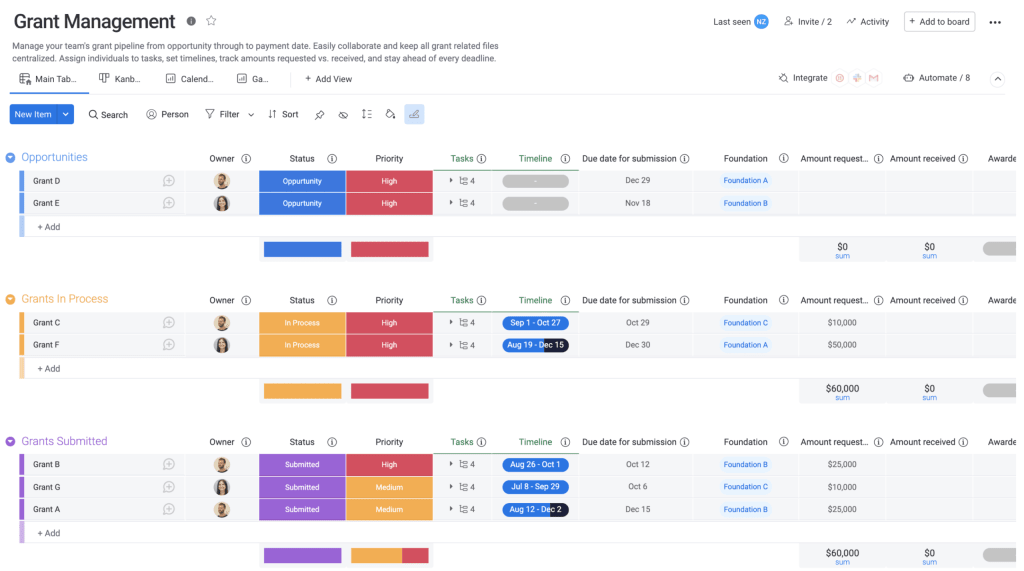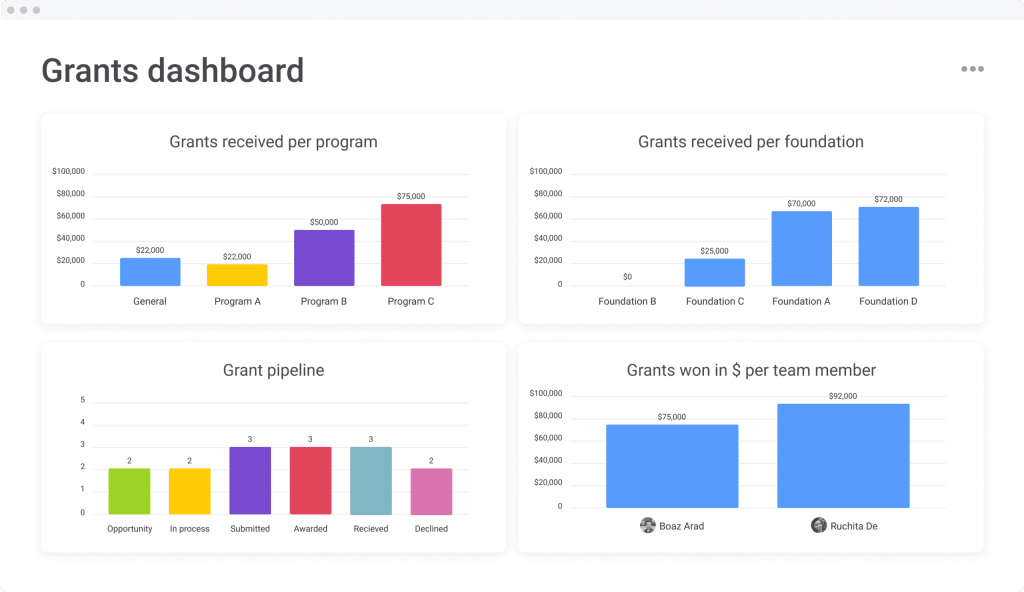Grants are an incredibly important source of funding for nonprofits. These funds are gifted to a nonprofit organization by a business that shares its mission and values. Unlike a loan, these funds do not need to be paid back and can be used to help the communities the nonprofit serves. This means that obtaining grants is as important as receiving donations from companies and individuals. In fact, grants often provide more funds than a donation, and are either offered by government organizations, private entities, or foundations and corporations looking to partner with nonprofits.
Applying for a grant can be a tedious and time-consuming task that involves plenty of paperwork. This is because organizations offering grants want to ensure that the nonprofit is going to use the money in the best way possible. In some cases, grantmakers will request the money be used for certain initiatives or projects, which will be clearly stipulated. This means that organizations can put restrictions on the grant funds, although this is not always the case. Because applying for grants can take lots of time and know-how, many nonprofits consider investing in grant management software for a more streamlined and efficient process.
What is grant management?
Nonprofits constantly face the challenge of adequate funding, with stats showing that 79% of nonprofits fail to launch due to a lack of sufficient funds. In these cases, it is important to submit a grant application to a government agency or business as it may be incredibly helpful to the success of your organization. Government grants are the most common types of grants for nonprofits. These are non-repayable funds given out by government organizations for nonprofits working for a good cause that positively impacts the community. That said, getting a government grant can be a tricky and tedious process and nonprofits have to meet the eligibility requirements. These requirements are strict and there is lots of competition in this space, which means nonprofits, has to carefully consider the eligibility terms before proceeding with the grant request. Grants can be awarded to any nonprofit that meets its eligibility requirements, including new nonprofits needing to get off the ground.
Another benefit is the availability of grants. Many government grants are widely available for organizations of all industries, including healthcare, education, sustainability and more. You can usually visit the website of the preferred government organization to see if your industry falls within their reach. Grant funding also adds a level of credibility to a nonprofit in the eyes of other donors, volunteers and potential partners. This helps in attracting more funding, donations and support in the future as most people want to support organizations that already have a solid platform in which to operate. Through grants, your nonprofit may be introduced to potential partners and resources, improving your chances of future success.
Finally, grants are limitless in that nonprofits can apply for as many grants as they like. There is no restriction or limit on this, so if your organization meets the requirements, there is a good chance of getting the grant you need to run your nonprofit effectively.
Submitting a nonprofit grant
Applying for a grant can seem daunting, especially if you’ve never done it before. One of the most intimidating steps will likely be drafting the grant proposal. Many times, nonprofits will hire a professional grant writer to craft the proposal as they have the necessary skills and requirements.
If you prefer to have the grant written in-house, remember to do thorough research before starting but the process can be simple if you follow the traditional steps grant writers use. In order to reach your fundraising goals faster, use grant management software like monday.com to easily plan, track and launch your campaigns. Users can also engage with advocates, donors, and supporters, manage grant applications, and automate personalized emails and texts, among many other helpful features.
Why is having a grant management process important?
Grants can be a complicated business, for both funders and grant seekers. For a grant management process to be successful, it must outline the current grant cycles and requirements. Many non-profits have to manage multiple grant awards, which means responsibilities need to be juggled and distributed fairly. As such, a system will help streamline the process to ensure deadlines are met and reporting is conducted. With an efficient process in place, non-profits can keep track of expected grant tasks and plan for future opportunities.
For a grant maker, it’s important to keep track of the number of grantees who rely on them for funding. They must also manage the board or advisory group approving the funding and ensure that all resources are distributed effectively. But using a grant management system, grant makers can provide clear guidelines to grantees, create opportunities and effectively recruit applicants in need of funding.

How nonprofits manage grants
In many cases, non-profits struggle to effectively manage grants. Not only is the process time-consuming and tedious, it also means non-profits must juggle running the organization with the administrative tasks of grant management. As a non-profit, it is important to familiarize yourself with the best practices for grant management so that you can make use of the funds in the best way possible and ensure prospective grant makers will provide funding in the future. As such, grant management skills is critical to ensure ongoing efficiency.
Larger non-profits may have the resources to employ a staff member to manage the grant process. Alternatively, they could have a dedicated department to oversee grant opportunities, manage grant applications and report on existing grant awards. These non-profits could even employ a grant manager to stay on top of all grant awards and reporting. This is not the case for smaller organizations. These non-profits typically cannot hire dedicated staff members for grant management.
In these cases, existing staff members need to balance their workload with managing grants, and many employees may not be skilled to do the job. In truth, the responsibilities of grant applications, writing grant reports and managing funds requires skilled, experienced staff. As such, these responsibilities will fall on top-level non-profit organizers like the Executive Director or Program Manager. Even then, these employees may need assistance from a bookkeeper, accountant or treasurer to ensure the funds are tracked and comply with the grant requirements.
For organizations dealing with just one or two grants, it’s possible to manage this using an Excel spreadsheet to keep track of expenses and deadlines. However, when an organization is dealing with multiple grants at the same time, it is important to utilize grant management software. In the same vein, grant makers can use the software to manage and track applications, post grant reports and stay updated on the most recent awarded funds.
That said, there are many grant management software tools available to help grant seekers and grant makers manage, organize and track processes. monday.com’s grant management system is ideal for both big and small organizations as it boasts features like grant trackers, deadline reminders, task lists and grant matching systems.
Tips for grant management best practices
Even small non-profits can benefit from grant management without the need for extra staff members or experts on duty. That said, there are a few guidelines to follow to ensure a smooth and streamlined process. Here are some tips to help you run a successful grant management system:
- Set up a grant opportunity calendar – Just like creating an annual budget, take a look at the upcoming year and outline your grant process using a calendar to track dates and deadlines. Do this by using a chart or spreadsheet, or making use of grant management software. You can identify grant opportunities that fit the needs of your organization and decide ones that are worth pursuing. Include this in your calendar as well as important notes and application deadlines. Additionally, you should include all expected award dates and post-award reporting requirements.
- Evaluate your budget and how the grant funding can be allocated – Most non-profits have multiple revenue streams. This is typically a combination of private donors, corporate sponsorships, grants and member fees. Your treasurer or accountant should be able to identify when grant funding is needed and find new grant opportunities worth pursuing. Make a realistic goal on what percentage of funding should come from grants and other sources of revenue. This will depend on the needs of the organization, its mission, long-term goals and funding model.
- Be proactive – Instead of starting a project then looking for funding or waiting for grant opportunities to present itself, be proactive in your search. Create a grant process that matches your mission, strategy and long-term funding goals. The funding you choose should align with these goals and timelines. This will help you keep track of all the stages of the grant lifecycle, stay organized and avoid missing deadlines or important requirements.

Grant management template
monday.com’s grant management template can help you plan, track and measure your nonprofit efforts, from mapping food deliveries to donated supplies. You can also create custom workflows, automate processes, and monitor your impact via live dashboards and intuitive software to help your business perform at its peak. Create a knowledge base with core documents related to grant programs, federal government reporting requirements, review processes, and grant applications—you can even create your own application forms in the platform that automatically populate your grant proposals workflows.
As a business that supports the hard work of nonprofit organizations, consider monday.com’s nonprofit program, where eligible organizations can receive a discount on grant management software. There are two plans available under the nonprofit program, which includes a 70% or 33% discount, respectively. It is important to read our eligibility guidelines to see if you qualify for this program.
To be eligible to qualify for the nonprofit program, organizations must be a recognized charity, nonprofit, nongovernmental, or social change organization based in an eligible country. As such, any organization applying for our nonprofit program must provide all legal documentation providing that you meet the criteria. We conduct a review process for all applicants to check eligibility and this is at our sole discretion.

